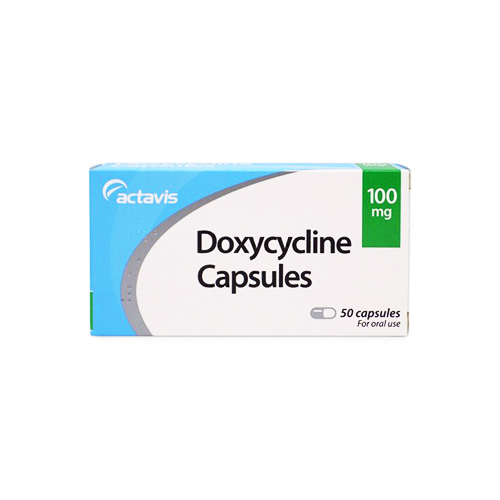- Clears Chlamydia
- Stops the growth of bacteria
- Effective antibiotic
Doxycycline
Doxycycline is an antibiotic belonging to a group of medicines called tetracycline. It is used to treat many different types of infections including sexually transmitted infections such as Chlamydia.
What is Doxycycline?
Doxycycline is an antibiotic. It is clinically effective in the treatment of a variety of infections caused by susceptible strains of Gram-positive and Gram-negative bacteria and certain other micro-organisms.
These bacteria are responsible for infections such as chest infections, skin infections, rosacea, dental infections and sexually transmitted infections (STIs),
Doxycycline can also be used to prevent malaria if you’re travelling abroad.
Doxycycline is available on prescription. It comes as capsules.
How does Doxycycline work?
Doxycycline belongs to a class of drugs called tetracyclines. Doxycycline works by blocking a bacterial protein from being made. It does this by binding to certain units of the protein. This stops the protein from growing and treats your infection.
How to use Azithromycin
The capsules should be swallowed with plenty of fluid in an upright position and well before going to bed. This is to reduce the likelihood of oesophageal irritation and ulceration.
If gastric irritation occurs, it is recommended that Doxycycline Capsules be given with food or milk.
Dosage
100mg twice daily for 7 days is recommended
Side effects & precautions
Permanent change of tooth colour warning: This drug may cause permanent changes in tooth colour in children if it’s used during tooth development. This time includes the last half of pregnancy through 8 years of age. Children’s teeth may change to yellow, grey, or brown.
Antibiotic-associated diarrhoea warning: This drug may cause antibiotic-associated diarrhoea. This can range from mild diarrhoea to severe infection of the colon. In rare cases, this effect can be fatal (cause death). If you have severe or persistent diarrhoea, tell your doctor. They may stop your treatment with this drug.
Intracranial hypertension warning: This drug may cause intracranial hypertension or high blood pressure inside your skull. Symptoms may include headache, blurry vision, double vision, and vision loss. Tell your doctor right away if you have these symptoms. You may also have swelling inside of your eyes. Women of childbearing age who are overweight have a higher risk of this condition. If you’ve had intracranial hypertension before, your risk is also higher.
Severe skin reaction warning: This drug can cause serious skin reactions. These include conditions called Stevens-Johnson syndrome, toxic epidermal necrolysis, and drug reaction with eosinophilia and systemic symptoms (DRESS). Symptoms can include blisters, peeling skin, and a rash of small purple spots. If you have any of these symptoms, stop taking this drug and call your doctor right away.
Like all medicines, this medicine can cause side effects, although not everybody gets them.
Common side effects
- loss of appetite
- nausea and vomiting
- diarrhoea
- rash
- sensitivity to the sun
- hives
- temporary discolouring of adult teeth (goes away with dentist cleaning after the drug is stopped)
Serious side effects
- severe diarrhoea
- bloody diarrhoea
- stomach cramping and pain
- fever
- dehydration
- loss of appetite
- weight loss
- High blood pressure inside your skull. Symptoms can include:
- headache
- blurry vision
- double vision
- vision loss
- irritation of your oesophagus or ulcers in your oesophagus (maybe more likely if you take your dose at bedtime). Symptoms can include:
- burning or pain in your chest
- anaemia
- Pancreatitis. Symptoms can include:
- pain in your upper abdomen, or pain in your abdomen that moves to your back or gets worse after you eat
- fever
- Serious skin reactions. Symptoms can include:
- blisters
- peeling skin
- a rash of small purple spots
Reporting of side effects
If you get any side effects, talk to your doctor. This includes any possible side effects not listed in this leaflet. You can also report side effects directly (see details below). By reporting side effects you can help provide more information on the safety of this medicine.
United Kingdom
Yellow Card Scheme
Website: www.mhra.gov.uk/yellowcard
or search for MHRA Yellow Card in the Google Play or Apple App Store.
Documentation
Doxycycline Patient Information Leaflet (PIL)



We’re here to help.
Our friendly team is available to help Monday to Friday 9:00am - 5:00pm.
If you need urgent assistance, do not use this service. Call 111, or in an emergency call 999.

